A ringtone is the sound made by a telephone to indicate an incoming telephone call. Originally referring to the sound of electromechanical striking of bells or gongs, the term refers to any sound by any device alerting of an incoming call.
The Nokia 3310 is a discontinued GSM mobile phone announced on 1 September 2000, and released in the fourth quarter of the year, replacing the popular Nokia 3210. It sold very well, being one of the most successful phones, with 126 million units sold worldwide, and being one of Nokia's most iconic devices. The phone is still widely acclaimed and has gained a cult status due to its reputation for durability.

The Nokia 5510 is a mobile phone announced on October 11, 2001 and released in December of that year. The Nokia 5510 features a full QWERTY keyboard, an 84 x 48 monochrome display, and is notable for its digital music player, the company's first mobile phone with music player capabilities. It has a 64 MB memory for storing audio files. Its successor is the Nokia 3300.
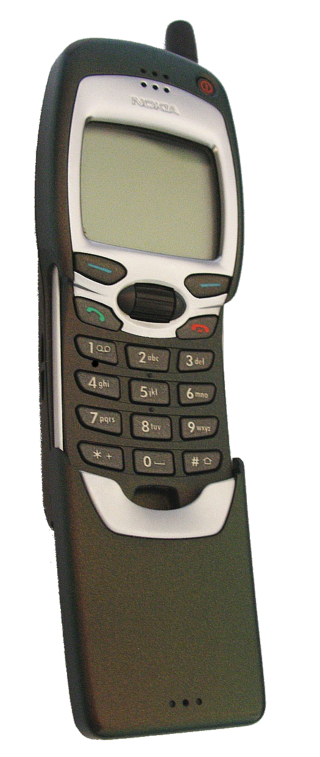
The Nokia 7110 is a GSM mobile phone announced in February 1999 and released in October 1999. It was the first mobile phone to run Series 40 and to come with a WAP browser.
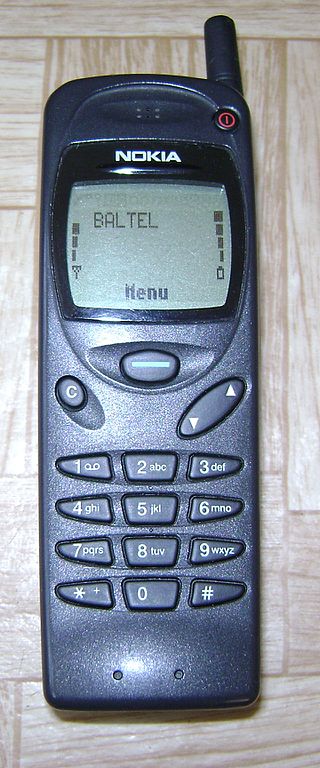
The 3110 is a GSM mobile phone handset manufactured by Nokia in Hungary, introduced at CEBIT in March 1997. The 3110 is notable as the first Nokia handset to feature the 'Navi-Key' menu navigation system. The Navi-Key was featured heavily on Nokia handsets, especially the entry-level models such as the Nokia 1100 in the following years. Unlike its successor, the 3210, and subsequent handsets of similar design, the 3110 had an external antenna. The phone was available with a slim, standard or vibrating battery. It could only be used on a GSM-900 network.
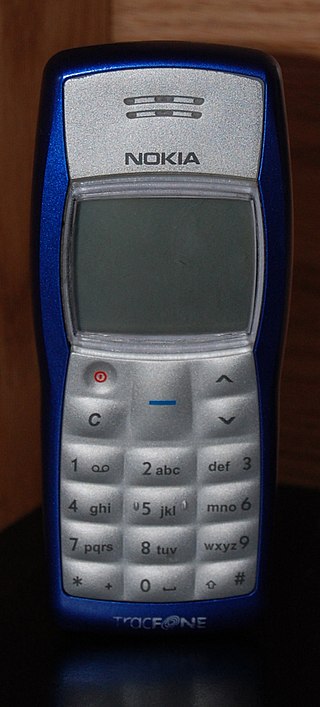
The Nokia 1100 is a basic GSM mobile phone produced by Nokia. Over 250 million 1100s have been sold since its launch in late 2003, making it the world's best selling phone handset and the best selling consumer electronics device in the world at the time. The model was announced on 27 August 2003 and was discontinued in September 2009.
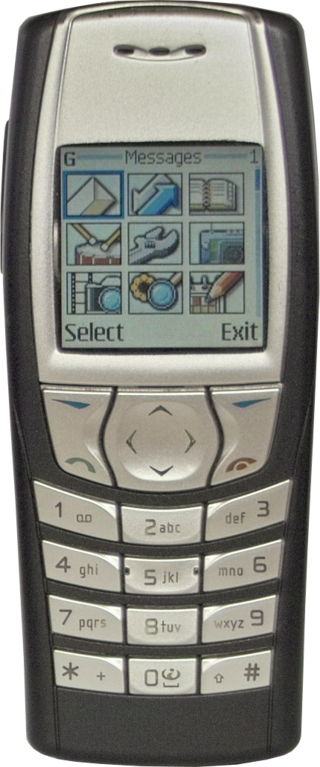
The Nokia 6610 is a handset by Nokia that uses the Series 40 platform and J2ME (Java). The device features text and picture messaging, a WAP browser, Stereo FM radio, Polyphonic ringtones and a 128x128, 4096-colour display. It is essentially the same phone feature-wise as the Nokia 7210, the 6610 being a more business-oriented version with a more conservatively-styled face plate and keypad layout, in contrast with the fashion-oriented 7210. It was introduced at CommunicAsia in June 2002 and was released in Q3 of the year.

The Nokia 7600 is a camera phone developed by Nokia, running on Series 40. The 7600 was announced on 25 September 2003 and was Nokia's second 3G handset after the Nokia 6650. It is notable for its unique radical design.

The Nokia 5110 is a GSM mobile phone that was introduced by Nokia on 12 April 1998.
The Ericsson R310s, produced by Ericsson Mobile Communications, now known as Sony Mobile Communications, was a mobile phone produced in the early 2000s in a rugged body designed for use in environments or ways which might easily damage a standard handset.

The Nokia 8850 is a mobile phone handset manufactured by Nokia. It was a light alloy-bodied enhanced version of Nokia 8210 model with slider protection of the keypad and white lighting of the keypad and screen. The 8850 is considered to be an un-repairable phone, thus resulting in very few active handsets in the market. Today it remains a collector's item. It also came in gold. It was introduced as a successor of an earlier model, the chrome phone Nokia 8810.

The Nokia 6300 is a mobile telephone handset produced by Nokia. It was announced on 28 November 2006 and released in January 2007. This model was assembled in several factories, including Jucu plant, near Cluj, in Romania.

The Nokia 3110 classic is a mobile phone handset, manufactured by Nokia in Hungary and released for sale in 2007. It is a budget model with similar features to the Nokia 6300. Although the phone bears the same model number as the 1997 Nokia 3110, it was not directly derived from this model.
The Motorola Aura is a series of luxury mobile phones from Motorola, which is part of the 4LTR line. The series was announced in October 2008 and made available for purchase by December of that year. Though originally intended to be a series, only one phone, the Aura R1, was ultimately released. However, three additional special editions of the Aura R1 were released throughout 2009: the Aura Diamoniqe Edition, Aura Celestial Edition and Aura Diamond Edition. The Aura was marketed as a luxury device, with a price tag of US$2000. It was made from premium materials, such as stainless steel and sapphire, in order to appeal to a larger audience and was packaged in a wooden box.

Nokia X3-00, is a multimedia-oriented mobile phone produced by Nokia. It comes with stereo-wide speakers, built-in FM radio with RDS, a standard 3.5 mm audio jack, media player and 3.2 megapixel camera. The phone runs under the Series 40 software platform. It was announced in September 2009 and later released in December 2009 worldwide.

Nokia 1280 is an affordable ultrabasic dual band GSM mobile phone made by Nokia announced in November 2009 and released in March 2010 for developing countries. It has a classic candybar design, intended to be lightweight and durable. Its related twin is Nokia 103, which is shipped in small quantities in developed markets.
The Nokia 7210 is a handset by Nokia, built on the Series 40 1st Edition software platform and enabled with J2ME (Java). The device features text and picture messaging, WAP browser, Stereo FM radio, Polyphonic ringtones, two preinstalled games and a 1.5", 128x128 pixel, 4,096 color display. It was the first Nokia phone for the mass market with a colour display and with polyphonic ringtones.
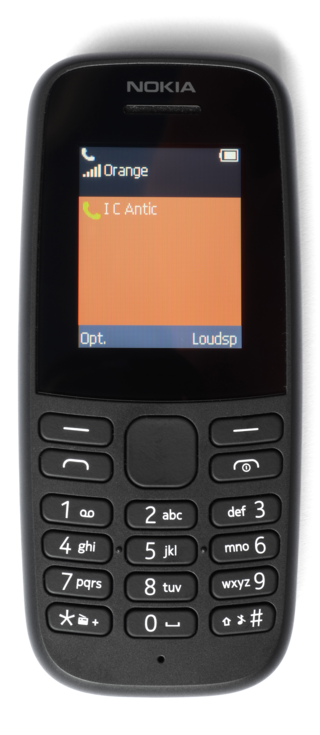
Series 30+ is a software platform and application user interface used for Nokia-branded mobile devices. The platform was introduced by Nokia in September 2013, first appearing on the Nokia 108, and has been the main Nokia feature phone operating system after the end of the Series 30 and Series 40 platforms in 2014. Despite the similar name and user interface, S30+ is technically completely different and unrelated to S30.

Human Mobile Devices (HMD), formally HMD Global, is a Finnish mobile phone manufacturer. The company is made up of the mobile phone business that the Nokia Corporation sold to Microsoft in 2014, then bought back in 2016. HMD began marketing Nokia-branded smartphones and feature phones on 1 December 2016. The company has exclusive rights to the Nokia brand for mobile phones through a licensing agreement. The HMD brand was initially only used for corporate purposes and does not appear in advertising, whereas the name "Nokia Mobile" is used on social media. As it was launched, the acronym HMD stood for Hon Hai Mobile Devices. This was in reference to the main shareholder at the time of its creation: the Taiwanese group Foxconn. In January 2024, HMD rebranded to 'Human Mobile Devices', and will use their own branding on future devices alongside that of Nokia.
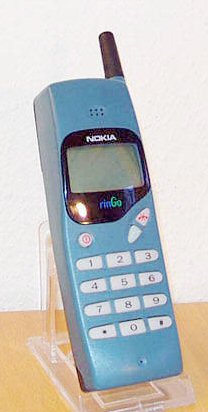
The Nokia rinGo is an entry-level analogue consumer mobile phone from Nokia, originally released for the analogue NMT-900 network in Finland, Norway, Sweden, Denmark and Netherlands. Two revisions were released afterwards.

















